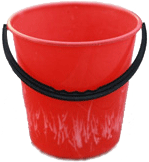How much to fill it?



This resource can be used to provide evidence of students' understanding of capacity (Y3/4) for Geometry and Measurement. In particular this resource assesses the ability to recognise the capacity of common containers which in turn underlies the ability to make meaning of "measuring" capacities.
- Students who identified all 3 containers correctly may be operating at curriculum level 2 (Year 4).
- Students who identified 2 containers correctly may be operating at early curriculum level 2 (Year 3).
For students who cannot identify the capacity of containers, asking them to order all three containers based on capacity may indicate whether they may be operating at curriculum level 1 (Year 2). Generally, asking students why they gave answers can be helpful to clarify their understanding.
| Y6 (10/2010) | ||
| a) | A | easy |
| b) | B | moderate |
| c) | B* | moderate |
NOTE:*The bucket is approximately 10 litres (actually 9+ litres)
This resource is about assessing students' sense of capacity by asking about the size of everyday containers. It is about students' knowledge and experience rather than being something they can solve. Sense of size is important knowledge in measurement, especially with regard to estimation. The items selected for this resource were everyday items that were intended to be accessible for students and teachers. Ultimately the idea behind this resource is that students will know about how much is 1 litre, or 2 litres, or 10 litres, or at least know the capacity of containers around their home and school environment.
Prior knowledge
- This resource relies upon students having experienced capacity maths problems and explored the size of different vessels for capacity. It is about their knowing based on experiencing, and exploring capacity. Often these experiences may be outside of school.
- Understanding the nature of estimation is also helpful for this measurement resource.
| Common response | Likely misconception | |
|
a) b) c) |
B A or C C or D |
Not knowing the size/capacity of containers (in litres) Essentially all these errors are likely to be guesses based upon the lack of students implicit understanding of the size of capacity, or that they cannot "remember" the size referred to on the containers, e.g., litre of milk. |
Did not correctly identified the capacity of the containers
Students who could not identify the correct size of the containers are likely to need an opportunity to work with a range of containers to develop spatial awareness with capacity. They will also need to know the capacity of the containers they are exploring using whole litre measurement. The first step may be to develop a sense of the size of 1 litre in different containers (e.g., half filled 2 litre bottle, 1000s place value block (equivalent to 1 litre), or other containers with 1 litre of liquid or sand) and visualising how large 1 litre is. Once students have developed a sense of 1 litre they can then begin to estimate and investigate using water (or sand) how many litres go into other containers (preferably all in litres or half litres). After this students should start to develop a sense of being able to estimate containers visually with some support from remembering other sized containers as benchmarks.
Identifying the bucket as 1 litre
Some students correctly identified the milk and the ice cream container, but thought that the bucket was 1 litre. This may suggest that larger containers (such as the 10L bucket) may be beyond students home and school experiences. Containers used for assessment are more valid if students recognise or have some experience with them.
Correctly identified the capacity of the containers
Students who could correctly identify the capacity of these containers could explore a wider range of containers of different shapes and include half measures, e.g., 1 1/2 litre soft drink bottles, 4 litre oil containers, 50 litre rubbish bins. As this exploration is about developing a sense of size students need to be aware that it is OK to use approximate quantities. For example, some rubbish bins are 45L and some are 50L; it would be very difficult to distinguish between a 45L and 50L rubbish bin without measuring them.
Using these other containers students could then estimate how many of one container would fill another container and then investigate alternative ways to find out. Examples could start with how many half litres in 4 litre container? How many 1 1/2 litres in 3L?
Once students are used to a range of containers measured in litres, they could explore other containers in millilitres, and eventually work between the two standard unit of measuring capacity (Note: converting between millilitres and litres is at Level 4 in the NZC).

